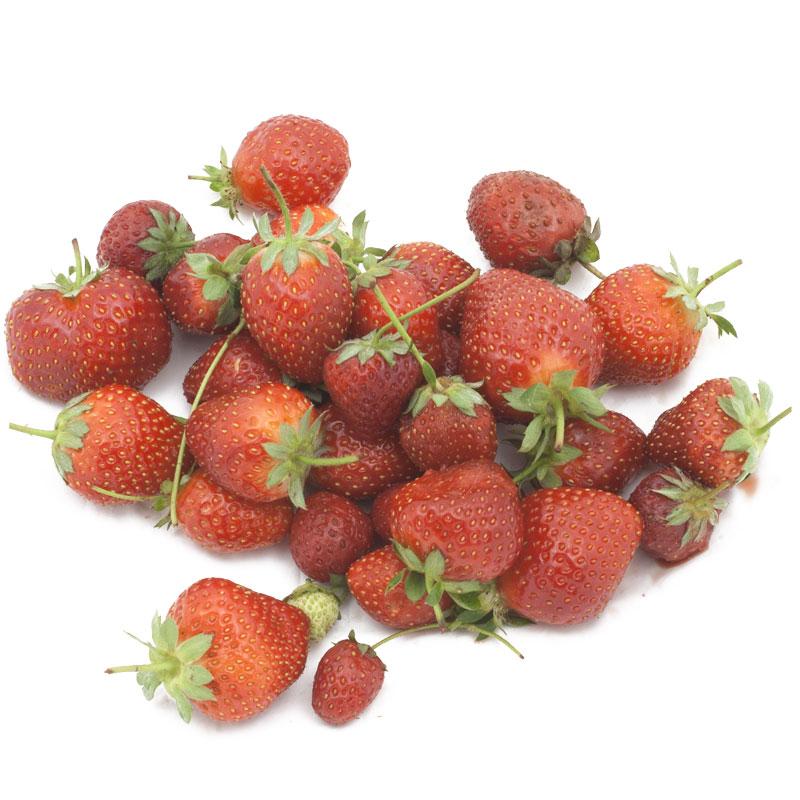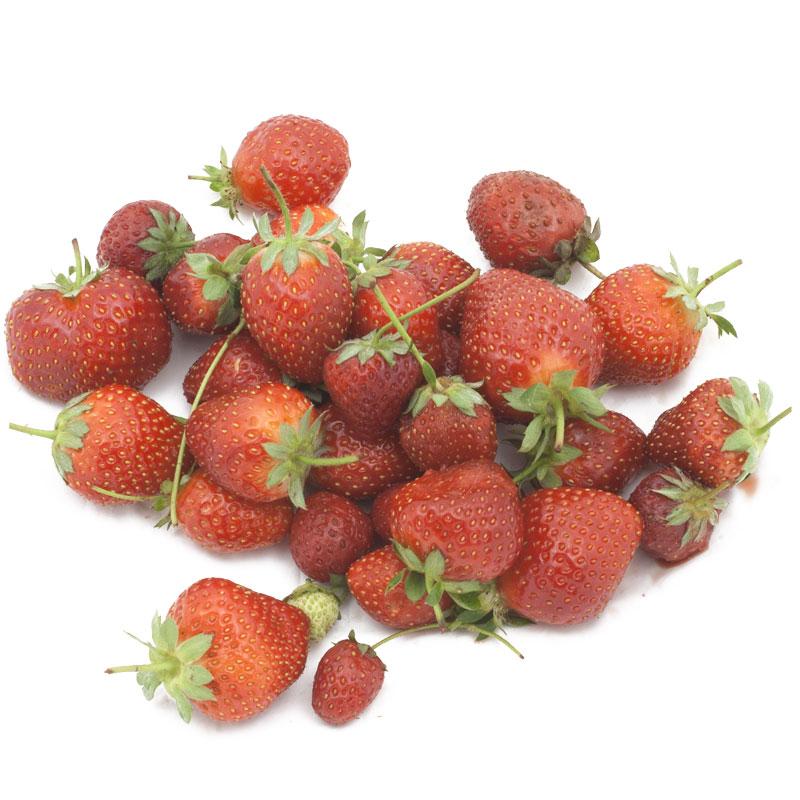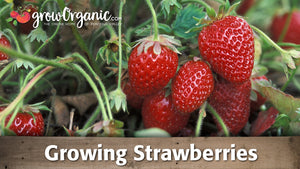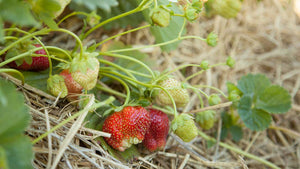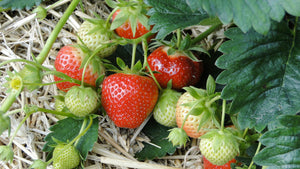Item Number: FV495
Sequoia Strawberry Plants (Bundle of Approximately 25)
Sequoia Strawberry Plants (Bundle of Approximately 25)
June Bearer Short Day
- Growing Zones: 3 to 10
- Chill Requirements: Strawberries usually do not require specific chill hours for fruiting.
- Bloom Time: Spring to early summer, depending on the local climate.
- Harvesting Dates: Late spring to early summer for most varieties, but this can vary based on the planting region and climate.
- Looks: Strawberries have green leaves and produce small white flowers that turn into the familiar red fruits upon ripening.
- Personality: Strawberries are generally hardy and adaptable plants, and some varieties, like Sequoia, are prized for their large, sweet fruits.
- Facts of Note: Strawberries are known to be rich in vitamin C, antioxidants, and dietary fiber. They are versatile and can be used in various culinary dishes.
- Pollinator: Many strawberry varieties are self-fruitful, meaning they do not require a separate pollinator for successful fruiting.
- Ideal Soil Temperatures: 60°F to 80°F (15°C to 27°C).
- Planting Depths: Planting depth can vary, but generally, roots should be buried and the crown (where the stem meets the roots) should be at the soil surface level.
- Germination Periods: Strawberries are often propagated from runners or purchased as seedlings rather than grown from seeds, so germination times might not be relevant.
- Height at Maturity: Strawberry plants typically grow to about 6 to 8 inches in height.
- Days to Maturity: Strawberries generally start producing fruit within 4 to 6 weeks after flowering.
- Sun/ Shade: Strawberries thrive in full sun but can tolerate partial shade.
- Spacing After Thinning: Proper spacing is crucial, usually about 12 to 18 inches apart for adequate air circulation and healthy growth.
Growing strawberries is a rewarding endeavor for any home gardener, offering luscious, sweet fruit and a delightful addition to any garden. Understanding the nuances of cultivating these red berries ensures a bountiful harvest and thriving plants. Select strawberry varieties suited to your region and garden conditions, considering factors like disease resistance and fruiting habits.
Sunlight Requirements:
Opt for a location with full sun exposure, ensuring at least 6-8 hours of direct sunlight daily for optimal growth.
Cultivation Essentials
Soil Preparation:
Prepare well-draining soil rich in organic matter, vital for healthy strawberry plants. Raised beds offer good drainage for these plants.
Spacing and Depth:
Plant strawberries approximately 18 inches apart in raised beds or containers, ensuring the crown is level with the soil surface.
Day-Neutral Strawberries
Continuous Fruit Production:
Day-neutral varieties produce fruit throughout the growing season, allowing for consistent yields beyond the typical harvest window.
Mother Plants and Runners:
Day-neutral strawberries produce runners, aiding in the creation of new mother plants, contributing to sustained fruit production.
Fruiting and Harvesting:
Fruit Development:
Strawberry plants start producing runners and flowers, ultimately forming berries. Expect red, succulent fruits with the June-bearing varieties.
Harvest Timing:
June-bearing varieties yield a single, concentrated harvest in early summer, while day-neutral strawberries offer continuous fruiting.
Optimizing Strawberry Growth:
Frost Protection:
Shield plants from early frost to safeguard the earliest spring crops and prolong the fruiting period.
California and Southern States:
Certain varieties thrive in warmer climates, performing exceptionally well in regions like California and the southern states.
Cultivating strawberries in your home garden involves choosing suitable varieties, providing ample sunlight, maintaining soil health, and ensuring proper care to enjoy a bounty of sweet, red berries. Understanding the distinct characteristics of different strawberry types empowers gardeners to foster healthy plants and relish the joy of a successful harvest.
June Bearers generally produce a single large crop in spring to early summer (as early as March in warmer regions) and are prolific producers for 3 to 4 weeks. Pick the blossoms off June bearers the first year to boost production the second year.
Everbearers are not as prolific as June bearers but are especially suitable for growers who wish to harvest a constant supply of berries throughout the summer. Plant some of both to have a large harvest to preserve, and plenty to eat all summer!
Full Box Quantities The plant count of a full box is 1500. If you buy a box, you will end up paying only $0.13/plant. These ship directly from the supplier.
Check out our full line of strawberries here: Strawberry Collection
The Strawberry 'Sequoia' is a delightful and enticing addition to any garden or berry patch. This particular strawberry variety, known for its unique aesthetic appeal and exceptional taste characteristics, is a favorite among both novice and experienced growers. In this summary, we will delve into the distinctive features of Strawberry 'Sequoia,' its growth requirements, and the delicious attributes that make it a standout choice for home gardeners.
Appearance and Aesthetic Characteristics:
Unique Berries: Strawberry 'Sequoia' boasts an alluring appearance with its large, heart-shaped berries. These berries are known for their stunning deep red color and glossy sheen, making them particularly appealing when displayed in the garden or arranged in culinary creations.
Ornamental Qualities: Beyond its delectable fruit, Strawberry 'Sequoia' adds ornamental value to your garden. The lush green foliage forms dense, attractive ground cover, enhancing the aesthetic appeal of your outdoor space. Its vibrant white flowers, which appear in spring, further contribute to its visual charm.
Compact Growth Habit: Strawberry 'Sequoia' is a compact plant, making it suitable for small gardens, containers, or hanging baskets. Its neat and well-behaved growth habit ensures that it doesn't overwhelm your garden space, making it an excellent choice for urban and suburban settings.
Taste Characteristics:
Exceptional Flavor: One of the standout qualities of Strawberry 'Sequoia' is its exceptional flavor. These berries are renowned for their delectable sweetness, balanced acidity, and rich strawberry essence. When fully ripened, they offer a taste that is both intensely sweet and satisfyingly juicy, making them a favorite among berry enthusiasts.
Versatile Culinary Uses: Strawberry 'Sequoia' is a versatile fruit that lends itself to various culinary applications. Whether you enjoy them fresh, in salads, as a topping for desserts, or as a key ingredient in jams and preserves, these strawberries are sure to elevate your culinary creations with their delectable flavor.
Long Harvest Season: One of the advantages of growing Strawberry 'Sequoia' is its extended harvest season. These berries start ripening in late spring and continue to produce fruit throughout the summer and into early fall, providing a continuous supply of delectable strawberries for your enjoyment.
Growth Requirements:
Sunlight: Strawberry 'Sequoia' thrives in full sun, requiring at least 6 to 8 hours of direct sunlight daily. Placing the plants in a sunny location ensures optimal fruit production and the development of their delicious flavor.
Soil: Well-drained, fertile soil is essential for the successful cultivation of Strawberry 'Sequoia.' Amending the soil with organic matter, such as compost, enhances its texture and nutrient content, promoting healthy growth and bountiful harvests.
Watering: Consistent and adequate moisture is crucial for strawberry plants. Watering should be regular but not excessive to prevent waterlogged conditions. Applying mulch around the plants helps retain soil moisture and suppress weeds.
Pruning: Regular pruning of Strawberry 'Sequoia' is recommended to maintain the plants' vitality and encourage better air circulation, reducing the risk of disease. Remove runners (elongated shoots) to direct energy towards fruit production.
Strawberry 'Sequoia' is a captivating berry plant that combines eye-catching aesthetics with exceptional taste characteristics. Its large, deep red, heart-shaped berries are not only visually appealing but also boast a delightful sweetness that makes them a favorite among fruit enthusiasts. With its compact growth habit and extended harvest season, Strawberry 'Sequoia' is a practical choice for gardens of all sizes. Whether enjoyed fresh, incorporated into culinary creations, or displayed as an ornamental addition to your garden, this strawberry variety promises a rewarding and flavorful gardening experience.
For more information, please enjoy our Growing Guide for planting and growing strawberries.
For more information on growing BIG strawberries organically, see our guide.


Check Your Zone Compatibility:
Compatible with your zone.
Growing Zone for
,

Our Guarantee To You
Since 1976, we've served our customers at every stage of growing. Please contact us at any time. We are happy to support and assist you.
Description
Description
- Growing Zones: 3 to 10
- Chill Requirements: Strawberries usually do not require specific chill hours for fruiting.
- Bloom Time: Spring to early summer, depending on the local climate.
- Harvesting Dates: Late spring to early summer for most varieties, but this can vary based on the planting region and climate.
- Looks: Strawberries have green leaves and produce small white flowers that turn into the familiar red fruits upon ripening.
- Personality: Strawberries are generally hardy and adaptable plants, and some varieties, like Sequoia, are prized for their large, sweet fruits.
- Facts of Note: Strawberries are known to be rich in vitamin C, antioxidants, and dietary fiber. They are versatile and can be used in various culinary dishes.
- Pollinator: Many strawberry varieties are self-fruitful, meaning they do not require a separate pollinator for successful fruiting.
- Ideal Soil Temperatures: 60°F to 80°F (15°C to 27°C).
- Planting Depths: Planting depth can vary, but generally, roots should be buried and the crown (where the stem meets the roots) should be at the soil surface level.
- Germination Periods: Strawberries are often propagated from runners or purchased as seedlings rather than grown from seeds, so germination times might not be relevant.
- Height at Maturity: Strawberry plants typically grow to about 6 to 8 inches in height.
- Days to Maturity: Strawberries generally start producing fruit within 4 to 6 weeks after flowering.
- Sun/ Shade: Strawberries thrive in full sun but can tolerate partial shade.
- Spacing After Thinning: Proper spacing is crucial, usually about 12 to 18 inches apart for adequate air circulation and healthy growth.
Growing strawberries is a rewarding endeavor for any home gardener, offering luscious, sweet fruit and a delightful addition to any garden. Understanding the nuances of cultivating these red berries ensures a bountiful harvest and thriving plants. Select strawberry varieties suited to your region and garden conditions, considering factors like disease resistance and fruiting habits.
Sunlight Requirements:
Opt for a location with full sun exposure, ensuring at least 6-8 hours of direct sunlight daily for optimal growth.
Cultivation Essentials
Soil Preparation:
Prepare well-draining soil rich in organic matter, vital for healthy strawberry plants. Raised beds offer good drainage for these plants.
Spacing and Depth:
Plant strawberries approximately 18 inches apart in raised beds or containers, ensuring the crown is level with the soil surface.
Day-Neutral Strawberries
Continuous Fruit Production:
Day-neutral varieties produce fruit throughout the growing season, allowing for consistent yields beyond the typical harvest window.
Mother Plants and Runners:
Day-neutral strawberries produce runners, aiding in the creation of new mother plants, contributing to sustained fruit production.
Fruiting and Harvesting:
Fruit Development:
Strawberry plants start producing runners and flowers, ultimately forming berries. Expect red, succulent fruits with the June-bearing varieties.
Harvest Timing:
June-bearing varieties yield a single, concentrated harvest in early summer, while day-neutral strawberries offer continuous fruiting.
Optimizing Strawberry Growth:
Frost Protection:
Shield plants from early frost to safeguard the earliest spring crops and prolong the fruiting period.
California and Southern States:
Certain varieties thrive in warmer climates, performing exceptionally well in regions like California and the southern states.
Cultivating strawberries in your home garden involves choosing suitable varieties, providing ample sunlight, maintaining soil health, and ensuring proper care to enjoy a bounty of sweet, red berries. Understanding the distinct characteristics of different strawberry types empowers gardeners to foster healthy plants and relish the joy of a successful harvest.
June Bearers generally produce a single large crop in spring to early summer (as early as March in warmer regions) and are prolific producers for 3 to 4 weeks. Pick the blossoms off June bearers the first year to boost production the second year.
Everbearers are not as prolific as June bearers but are especially suitable for growers who wish to harvest a constant supply of berries throughout the summer. Plant some of both to have a large harvest to preserve, and plenty to eat all summer!
Full Box Quantities The plant count of a full box is 1500. If you buy a box, you will end up paying only $0.13/plant. These ship directly from the supplier.
Check out our full line of strawberries here: Strawberry Collection
The Strawberry 'Sequoia' is a delightful and enticing addition to any garden or berry patch. This particular strawberry variety, known for its unique aesthetic appeal and exceptional taste characteristics, is a favorite among both novice and experienced growers. In this summary, we will delve into the distinctive features of Strawberry 'Sequoia,' its growth requirements, and the delicious attributes that make it a standout choice for home gardeners.
Appearance and Aesthetic Characteristics:
Unique Berries: Strawberry 'Sequoia' boasts an alluring appearance with its large, heart-shaped berries. These berries are known for their stunning deep red color and glossy sheen, making them particularly appealing when displayed in the garden or arranged in culinary creations.
Ornamental Qualities: Beyond its delectable fruit, Strawberry 'Sequoia' adds ornamental value to your garden. The lush green foliage forms dense, attractive ground cover, enhancing the aesthetic appeal of your outdoor space. Its vibrant white flowers, which appear in spring, further contribute to its visual charm.
Compact Growth Habit: Strawberry 'Sequoia' is a compact plant, making it suitable for small gardens, containers, or hanging baskets. Its neat and well-behaved growth habit ensures that it doesn't overwhelm your garden space, making it an excellent choice for urban and suburban settings.
Taste Characteristics:
Exceptional Flavor: One of the standout qualities of Strawberry 'Sequoia' is its exceptional flavor. These berries are renowned for their delectable sweetness, balanced acidity, and rich strawberry essence. When fully ripened, they offer a taste that is both intensely sweet and satisfyingly juicy, making them a favorite among berry enthusiasts.
Versatile Culinary Uses: Strawberry 'Sequoia' is a versatile fruit that lends itself to various culinary applications. Whether you enjoy them fresh, in salads, as a topping for desserts, or as a key ingredient in jams and preserves, these strawberries are sure to elevate your culinary creations with their delectable flavor.
Long Harvest Season: One of the advantages of growing Strawberry 'Sequoia' is its extended harvest season. These berries start ripening in late spring and continue to produce fruit throughout the summer and into early fall, providing a continuous supply of delectable strawberries for your enjoyment.
Growth Requirements:
Sunlight: Strawberry 'Sequoia' thrives in full sun, requiring at least 6 to 8 hours of direct sunlight daily. Placing the plants in a sunny location ensures optimal fruit production and the development of their delicious flavor.
Soil: Well-drained, fertile soil is essential for the successful cultivation of Strawberry 'Sequoia.' Amending the soil with organic matter, such as compost, enhances its texture and nutrient content, promoting healthy growth and bountiful harvests.
Watering: Consistent and adequate moisture is crucial for strawberry plants. Watering should be regular but not excessive to prevent waterlogged conditions. Applying mulch around the plants helps retain soil moisture and suppress weeds.
Pruning: Regular pruning of Strawberry 'Sequoia' is recommended to maintain the plants' vitality and encourage better air circulation, reducing the risk of disease. Remove runners (elongated shoots) to direct energy towards fruit production.
Strawberry 'Sequoia' is a captivating berry plant that combines eye-catching aesthetics with exceptional taste characteristics. Its large, deep red, heart-shaped berries are not only visually appealing but also boast a delightful sweetness that makes them a favorite among fruit enthusiasts. With its compact growth habit and extended harvest season, Strawberry 'Sequoia' is a practical choice for gardens of all sizes. Whether enjoyed fresh, incorporated into culinary creations, or displayed as an ornamental addition to your garden, this strawberry variety promises a rewarding and flavorful gardening experience.
For more information, please enjoy our Growing Guide for planting and growing strawberries.
For more information on growing BIG strawberries organically, see our guide.
About Strawberries: Strawberries are extremely adaptable and are grown in every state in the U.S. Plants generally grow 6-8" tall and 12" across, are shallow-rooted, and benefit from mulch such as straw, pine needles, or plastic. Prefer a soil rich in all the basic nutrients with a pH of 6 to 6.5. Susceptible to root rot and must be planted in well-drained soil, with crown set at soil level. Yield under the best of conditions is about one basket per plant per season.
June Bearers generally produce a single large crop in spring to early summer (as early as March in warmer regions) and are prolific producers for 3 to 4 weeks. Pick the blossoms off June bearers the first year to boost production the second year.
Everbearers are not as prolific as June bearers but are especially suitable for growers who wish to harvest a constant supply of berries throughout the summer. Plant some of both to have a large harvest to preserve, and plenty to eat all summer!
Full Box Quantities The plant count of a full box is 1,500. These ship directly from the supplier.
Shipping Information
Shipping Information
Cannot ship to the following states: HI, AK, PR, GU, VI
Cannot ship via SmartPost.
Shipping Weight: 1.75 lb
Dimensions: 6.0"L x 3.0"W x 3.0"H
Features
Features
- Container Compatible
- Good for Beginners
- Long-Lived
- Plant Spreads
- Self-fruitful
- Suited to Warmer Climates
- Thornless
Characteristics
Characteristics
Planting & Care
Planting & Care
Useful Information
Useful Information
Guarantee
Guarantee
Limited Dormant Tree & Plant Guarantee
* Claim deadline is June 15th
We guarantee that your dormant tree or plant will arrive in good, viable condition. If your tree arrives in substandard condition, notify us within 3 days of delivery. Please email pictures of the box, inside packaging, the tree and its roots to helpdesk@groworganic.com. We will investigate your claim and process a request to exchange or refund the damaged product.
If your dormant tree or plant has not grown new leaves by June 15th, you may be eligible for our Limited Dormant Tree & Plant Guarantee. This guarantee provides for a store credit for the purchase price of the tree, excluding shipping. Please see the Instructions below.
Important Dates:
- April 1st Dormant trees/plants must be planted in the ground
- May 15th Perform scratch test, if no new leaves have grown
- June 15th Deadline to apply for a dormant tree/plant credit
All required documentation must be received by June 15th for your claim to be considered. Claims or documentation received after June 15th will be denied, without exception. Instructions listed below
Terms and Conditions
We cannot guarantee that your tree or plant will remain alive and healthy after it is received, or bear fruit as there are too many variables in your environment that are beyond our control (i.e. soil preparation, weed and pest control, proper irrigation, chill hours, compatible hardiness for your growing zone, proper choice of pollinator, extreme weather, rodent damage, disease, etc.).
We cannot guarantee that we will be able to provide a replacement tree/plant of the same species either that same growing season or in future years. Customers are responsible for all shipping fees associated with replacement trees and plants.
If we determine that the tree you purchased directly from us is not viable, we will issue you a store credit (not a refund) for the purchase price of the affected dormant tree or plant. Shipping is not included in the dormant tree/plant guarantee. Store credits can be used to purchase any product we sell and are valid for use only until July 1st of the following year.
Historically, 98% of our dormant trees and plants grow and thrive when they have been cared for and planted using our growing guides. Dormant trees and plants must be planted in the ground by April 1st in order to be eligible for credit. If the ground in your area is still frozen solid, you may temporarily plant your tree or plant in a pot.
Potted, non-dormant trees or plants are excluded from this guarantee as they are not dormant at the time of shipment. Evergreen trees such as citrus, avocado and olive trees are not available for credit under the Dormant Tree and Plant Guarantee.
Instructions
We guarantee that your dormant fruit tree or plant will leaf out, if you care for it according to our growing guides. In the unlikely event that your dormant tree or plant does not have leaves by May 15th, follow these simple steps to apply for a store credit:
Before you call or email, please perform a “scratch test” to determine if the tree or plant is still alive. This video shows how to check for live tissue under the bark. Scratch tests need to be done a few inches above and below the graft.
Green Cambium Layer / Living Trees
If the cambium layer under the bark is green, give your tree a little more time. It is still alive, but hasn’t come out of dormancy yet. Check to make sure that it is getting the right amount of deep root water, enough sunlight and that the weather is warm enough for that type of tree/plant to come out of dormancy. Every tree has its own personality and will come out of dormancy at different times. Be sure to submit the required documentation listed below by June 15th, if it doesn’t grow leaves.
Brown Cambium Layer / Dead Trees
If the scratch test shows a brown cambium layer or if your dormant tree/plant doesn’t have leaves by June 1st, please email us at helpdesk@groworganic.com. All required documentation listed below must be received by June 15th for your claim to be considered. To be considered for the guarantee claim, all required documentation must be received by June 15th. Incomplete submissions will be denied.
Required Documentation
- Order number
- Name of dormant tree/plant and the quantity affected
- Photos of each tree or plant showing:
- The roots (tree or plant must be pulled out of the ground)
- The scratch test areas
- The entire tree/plant
We reserve the right to not issue credit for items that have already been replaced. We also reserve the right to require photographic evidence that the tree/plant was not killed by root rot, rodent or mechanical damage.
Share
